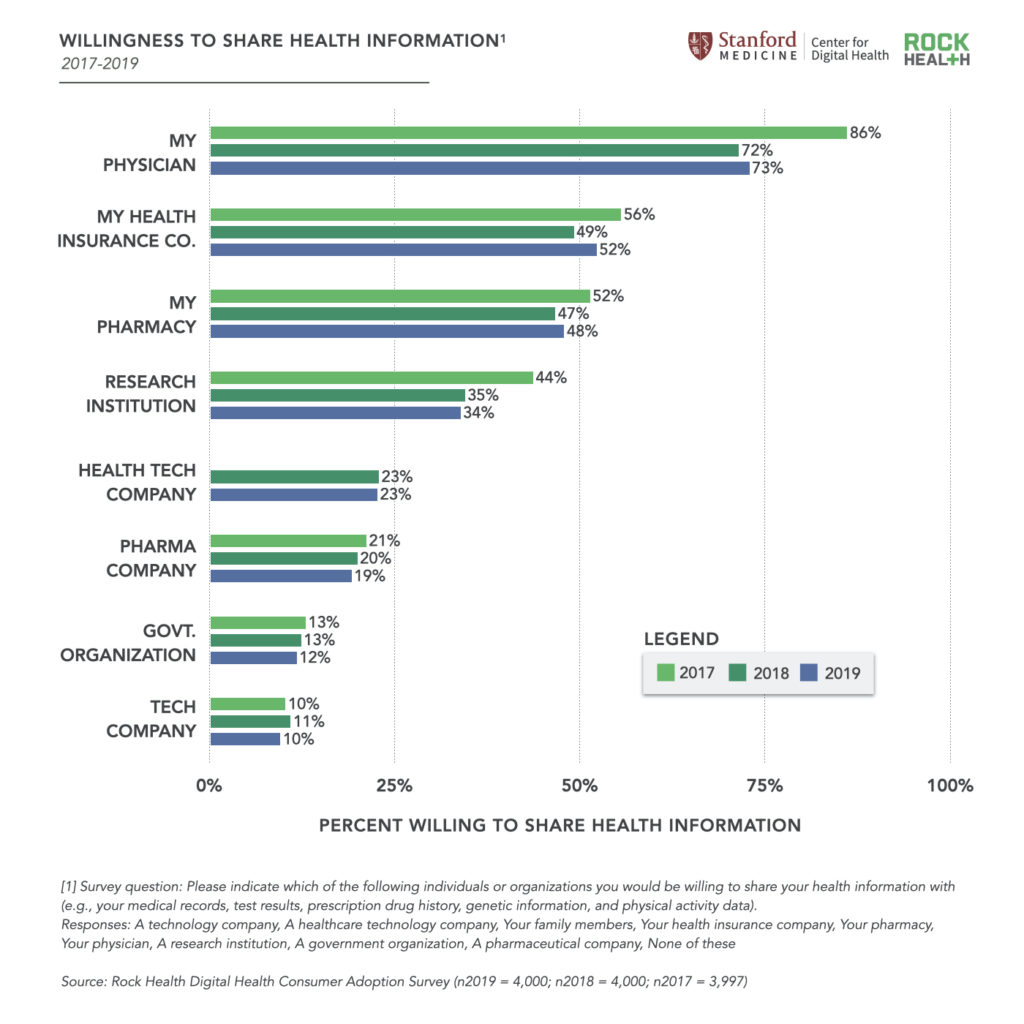Back to work, not back to normal
So long summer 2020—you’ve been…different. Students are returning to their physical and virtual classrooms, while workers continue to navigate remote work, PPE-laden in-office work, or unemployment. As federal unemployment support wanes and labor market gains slow, there is enormous pressure to get the economy back to work as soon and as safely possible. While the debate around the future of remote work rages on, entire sectors and segments of the population do not have the luxury of working from home.
Many measures need to be taken to bring students and employees back to classrooms and workplaces, ranging from PPE distribution and health screenings to space repurposing and community dialogue. Amidst all this, there is a big opportunity for digital health in the new “back to work” market (which we use to refer to solutions for both school and workplace re-opening), and digital health, healthcare, and technology organizations are rushing to capture a piece of it.
How does digital health get us back to work?
Digital health solutions have been selling to employers for years, but during the current return to work efforts, the employer channel has never been a better fit. Technology is being developed and tailored to address several core needs of employees:
- Health screening: tools to ensure workers are healthy before they enter the workplace
- Monitoring: sensors to track biometrics and alert of a change in health status
- Contact tracing: systems for tracking workers’ proximity to each other, in case an outbreak occurs
- Testing: active infection and antibody tests
- Communication: solutions for employee safety training, communication among employees and employers
- Employee support: resources for mental and emotional health
- Management tools: solutions for employers to track workplace- and community-level health data, and managing back to work processes
Looking ahead, the return to work may begin with a daily health screen—in fact, it already does for some essential workers today. Digital health solutions simplify and automate the steps for COVID-19 screening in the workplace. Employees can open an app, share any COVID-19-related symptoms they are experiencing, and receive guidance as to whether they are clear to go to work, if they should quarantine, or if they should seek medical attention. Some employees will even receive or be able to integrate their own at-home monitoring devices such as wearables, connected thermometers, pulse oximeters, and smartphones. Testing resources will also be made available to employees with coronavirus-like symptoms—some employees may be directed to nearby testing sites, while others will have access to in-workplace tests or at-home tests sent by mail. In-workplace contact tracing systems will be deployed via employee smartphones or other bluetooth enabled devices.
Both employers and employees will benefit from technology that supports the organizational, community, and personal challenges of the COVID-era workplace. Employers will need help managing staggered schedules and cohorts as such practices become standard in many schools and workplaces. In order to return to work confidently, employees need assurances that colleagues are following safe practices both in the workplace and at home. Digital employee education platforms can safely disseminate content about new workplace rules and at-home safety guidelines, and validate that all returning employees have completed the training. To help employees manage the mental and emotional toll of the pandemic and return-to-work, some employers are expanding access to virtual mental health resources.
Who is competing in the back to work market?
The back to work market is less than six months old, but it’s filled with major healthcare, digital health, and technology players. Digital health and technology companies that already have an established footprint among employers are well positioned to roll out new screening tools quickly. For example, Collective Health announced Collective Go in May—the back to work solution incorporates employee health screening and enterprise software for monitoring symptoms, test results, and compliance reporting. The company partners with other digital health startups Color, Everlywell, and Genalyte for testing. Salesforce also announced its back to work solution, Work.com, in May. This suite of tools also includes health screening tools for employees, as well as schedule management and manual contact tracing software. In August, Salesforce and CVS announced a partnership to integrate CVS’s Return Ready testing solution, which offers a combination of rapid worksite testing and drive-thru testing locations, with Work.com.
In the race to win the back to work market, companies are launching where their existing assets are adapted most easily. Competing in employee screening and monitoring are companies such as:
- Fitbit, which offers wearable-based monitoring of flu-like symptoms
- Buoy, which offers a chatbot-based screener and triage tool
- Sonde, which offers voice analysis-based respiratory symptom screening
- Binah, which offers smartphone-based monitoring of oxygen saturation, respiration rate, heart rate, and temperature
The employee testing landscape includes mostly large legacy companies like LabCorp, Quest, and Kroger Health, each of which are offering a mix of at-home, in-workplace, and drive-thru options. Tech-enabled primary care providers One Medical and Carbon Health offer comprehensive back-to-work platforms with testing and tools such as screening, education, contact tracing, and cohorting, in addition to virtual primary care. One Medical also offers virtual mental health support for employees returning to work.
Do we trust our employers with our health data?
In the pre-COVID world, there is good reason to believe that employees would balk at sharing healthcare information directly with their employer. Fewer than one in four respondents to Rock Health’s Digital Health Consumer Adoption Survey were willing to share their health data with healthcare technology companies, government organizations, or tech companies last year. We haven’t historically asked about healthcare data-sharing with employers (we are in this year’s survey—stay tuned), but we have a hard time imagining that those respondents would be thrilled with the idea of sharing health data with their employer.

The COVID-19 pandemic will likely change this calculus: we anticipate people may be likelier to share their healthcare data with various entities. As we pointed out in May’s blog post on contact tracing, individuals will be more willing to share their health data if the value they experience in return outweighs the costs, risks, and habitual resistance to sharing data. This trust equation is different for back to work technology than for traditional, pre-COVID digital health technology. People may only be willing to go back into the office if they can trust their coworkers are following safety measures—everyone has to share data for anyone to feel confident in their own safety. At the same time, employers may wield new power during the COVID economic downturn. Employees could be less willing to speak out against data collection practices if they feel their job is already at risk and their alternative job prospects are diminished during this recession. Serious data protection and privacy measures must be put in place to prevent unnecessary and inappropriate use of employer-collected health data.
What’s the long game? Opportunities in the post-COVID world
Today’s pre-vaccine limbo is unique. The back to work market opportunity is potentially large, but lockdowns will end and the urgency for back to work solutions will decline as COVID-19 vaccinations become widely accessible (your bet on when is as good as ours). What will be the lasting impact from these innovations? Here are some thoughts.
A new landscape of digital health partnerships
Many of the players in this new market are forming partnerships to construct comprehensive back to work offerings. When the dust settles, there will be new healthcare, technology, and digital health partnerships that have experience selling to the employer market. We’d be surprised if these new partners don’t continue to innovate together.
A new front door for employee health and wellness
Most back to work solutions incorporate a simple health screening tool that employees use every day before work. Over time, these solutions can evolve into digital front doors to employee’s healthcare journeys. Employees could notify their employer when taking a sick day by logging into solutions that integrate with both HR platforms and virtual care offerings.
Critical US infrastructure for future pandemics
We hope for and expect a significant government response to prepare the US for another, potential future pandemic—contact tracing, health screening, and the exchange and analysis of such data should be foundational technologies in our future pandemic response infrastructure. There may be lucrative government contracts up for grabs, and winners of the back to work race may be well positioned to play a role.
New insights on the impact of health on work (and vice versa)
With the appropriate aggregation and anonymization, there is an opportunity to draw connections between employee health and wellness and outputs such as company productivity. We’d love to see a large sample economic analysis of such data. We expect some large employers will glean insights about their workforce’s health and wellness-productivity relationship. We don’t want (or expect) the development of big brother-employers using daily wellness screenings as a management tool.
Digital health is changing healthcare today
Helping workers return safely to the workplace is but one of the many ways the digital health community is combating the COVID-19 pandemic. We’re proud of the way our portfolio companies have stepped in to tackle the challenge. The speed with which the back to work players have partnered together and entered this new market is simply one more signal that healthcare’s new world order is already here.
If you’re an enterprise organization interested in accessing more of Rock Health’s thought leadership on the latest trends and topics in digital health or working with our strategy consulting team on your tailored needs, reach out to us at advisoryservices@rockhealth.com

